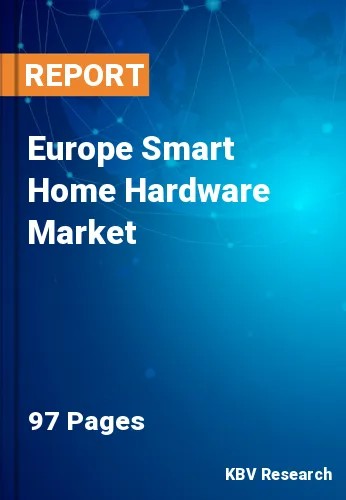The Europe Smart Home Hardware Market would witness market growth of 12.2% CAGR during the forecast period (2022-2028).
Connectivity has two purposes. For starters, it enables data transmission among the product and its operational environment, as well as between the product's producer, consumers, and other systems and products. Second, connectivity allows some product functionalities to reside outside of the physical device, in the so-called product cloud. In Bose's new Wi-Fi system, for instance, a smartphone application operating in the product cloud sends music from the internet to the system. All three kinds of connectivity are required to reach great levels of functionality.
All manufacturing sectors are seeing the rise of smart, connected products. For example, ABB's smart grid technology in the energy sector allows utilities to evaluate massive volumes of real-time data throughout a broad array of generating, converting, and distribution equipment, like temperature variations in secondary substations and transformers. It notifies utility control centers of potential overload circumstances, allowing for modifications that can avoid blackouts before it happen. Home automation is a network of communication, hardware, and electronic interfaces that operate together over the Internet to connect daily things. Each item contains sensors and is connected to the internet via WiFi, allowing the user to control it from anywhere in the world using the tablet or smartphone.
People in the Europe region have shown a huge demand and signs of popularity for smart home hardware systems and reasons behind this popularity is the awareness of smart technologies like the internet of things, etc. The Commission's vision for the electrical market which strives to create a fresh deal for consumers, smart homes and networks, data management and protection. Throughout the EU, a broad array of publicly supported programs are aimed at involving consumers in the vision. Clear assumptions that families want to play a more active part in the energy system underpin the EU's strategic aims for a smart home future. From a policy standpoint, smart homes are allowing technologies that allow homeowners to control and handle their energy usage at home. As a result, smart houses are viewed as an important component of a future energy-efficient system, assisting to lower overall demand while also reducing supply limitations during peak load hours.
The Germany market dominated the Europe Smart Home Hardware Market by Country in 2021, and would continue to be a dominant market till 2028; thereby, achieving a market value of $3,130.8 Million by 2028. The UK market is anticipated to grow at a CAGR of 11.2% during (2022 - 2028). Additionally, The France market would showcase a CAGR of 13% during (2022 - 2028).
Based on Product, the market is segmented into IoT Hardware for Control & Connectivity Devices, IoT Hardware for Security & Surveillance Equipment, and IoT Hardware for Smart Appliances. Based on countries, the market is segmented into Germany, UK, France, Russia, Spain, Italy, and Rest of Europe.
Free Valuable Insights: The Global Smart Home Hardware Market Size will Hit $48 Billion by 2028, at a CAGR of 12.5%
The market research report covers the analysis of key stake holders of the market. Key companies profiled in the report include Google LLC, Amazon.com, Inc., Schneider Electric SE, Honeywell International, Inc., ABB (ASEA Brown Boveri) Group, Johnson Controls International PLC, Panasonic Corporation, Legrand S.A., Samsung Electronics Co. Ltd., and General Electric (GE) Co.
By Product
By Country
Our team of dedicated experts can provide you with attractive expansion opportunities for your business.

